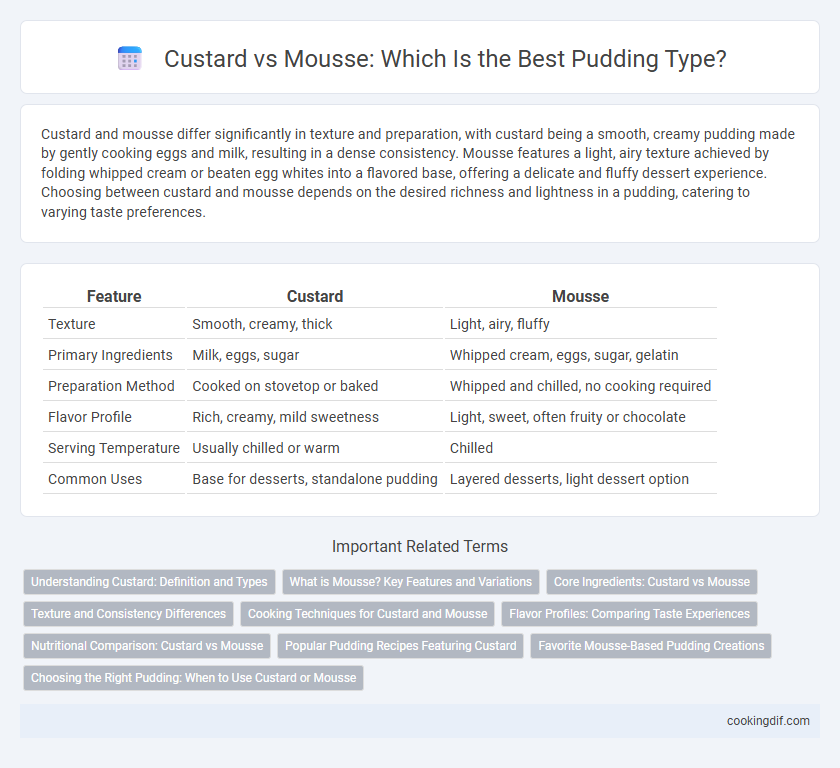Custard and mousse differ significantly in texture and preparation, with custard being a smooth, creamy pudding made by gently cooking eggs and milk, resulting in a dense consistency. Mousse features a light, airy texture achieved by folding whipped cream or beaten egg whites into a flavored base, offering a delicate and fluffy dessert experience. Choosing between custard and mousse depends on the desired richness and lightness in a pudding, catering to varying taste preferences.
Table of Comparison
| Feature | Custard | Mousse |
|---|---|---|
| Texture | Smooth, creamy, thick | Light, airy, fluffy |
| Primary Ingredients | Milk, eggs, sugar | Whipped cream, eggs, sugar, gelatin |
| Preparation Method | Cooked on stovetop or baked | Whipped and chilled, no cooking required |
| Flavor Profile | Rich, creamy, mild sweetness | Light, sweet, often fruity or chocolate |
| Serving Temperature | Usually chilled or warm | Chilled |
| Common Uses | Base for desserts, standalone pudding | Layered desserts, light dessert option |
Understanding Custard: Definition and Types
Custard is a creamy dessert made from a mixture of milk or cream, egg yolks, sugar, and flavorings, thickened by gentle cooking. There are several types of custard, including stirred custard (such as creme anglaise), baked custard (like flan or quiche), and pastry cream commonly used in fillings. Unlike mousse, custard has a denser, smoother texture due to the coagulation of eggs during cooking, making it distinct in both preparation and consistency.
What is Mousse? Key Features and Variations
Mousse is a light, airy dessert made by folding whipped cream or egg whites into a flavored base such as chocolate, fruit purees, or coffee, creating a smooth and creamy texture distinct from custard's denser consistency. Key features of mousse include its rich yet delicate mouthfeel, the use of gelatin or agar to stabilize the mixture, and its ability to be served chilled or frozen, making it versatile across various culinary traditions. Popular variations range from classic chocolate mousse to fruit-flavored versions like raspberry or passionfruit, each highlighting the dessert's characteristic fluffiness and intense flavor profile.
Core Ingredients: Custard vs Mousse
Custard relies primarily on eggs, milk, and sugar, using the eggs as a thickening agent to create a smooth, creamy texture. Mousse incorporates whipped cream or beaten egg whites, giving it a light, airy consistency, often flavored with chocolate or fruit purees. The key distinction lies in custard's dense, velvety structure versus mousse's fluffy, delicate composition.
Texture and Consistency Differences
Custard boasts a smooth, creamy texture achieved through the gentle cooking of eggs and dairy, resulting in a thick yet silky consistency. Mousse features a light, airy texture created by folding whipped cream or egg whites into the base, offering a fluffy and delicate mouthfeel. The distinct preparation methods define custard's dense richness versus mousse's ethereal fluffiness in pudding varieties.
Cooking Techniques for Custard and Mousse
Custard relies on precise temperature control and slow cooking techniques, often using a double boiler or bain-marie to gently thicken eggs and dairy without curdling. Mousse incorporates whipped cream or egg whites folded into a flavored base, requiring careful aeration to achieve a light, airy texture. Both desserts demand attention to ingredient temperature and timing to balance consistency and flavor in pudding preparation.
Flavor Profiles: Comparing Taste Experiences
Custard offers a rich, creamy texture with a smooth vanilla or caramel flavor that provides a classic, comforting taste experience. Mousse delivers a lighter, airy consistency with pronounced chocolate or fruit flavors, creating a more vibrant and refreshing sensation. Both custard and mousse cater to different palettes, where custard emphasizes richness and warmth, while mousse highlights brightness and delicacy in taste.
Nutritional Comparison: Custard vs Mousse
Custard typically contains higher protein and calcium levels due to its egg and milk base, while mousse often has increased fat content from whipped cream or chocolate. Custard generally has fewer calories and less sugar compared to mousse, which can be richer and sweeter depending on added ingredients. Nutritionally, custard offers more essential vitamins like vitamin A and B12, whereas mousse provides a more indulgent texture with higher saturated fat.
Popular Pudding Recipes Featuring Custard
Popular pudding recipes featuring custard often highlight its rich, creamy texture achieved by slowly cooking a mixture of eggs, milk, and sugar until thickened. Unlike mousse, which relies on whipped cream or egg whites for a light, airy finish, custard-based puddings deliver a denser, silkier mouthfeel ideal for classic desserts like creme brulee and flan. Traditional custard recipes emphasize smoothness and depth of flavor, making them staples in comfort food and elegant dessert menus.
Favorite Mousse-Based Pudding Creations
Mousse-based puddings offer a light, airy texture compared to the creamy, dense consistency of custard, making them a favorite for those who prefer a delicate dessert experience. Popular mousse-based pudding creations include chocolate mousse pudding, which combines rich dark chocolate with whipped cream for a smooth finish, and fruit-flavored mousses like raspberry or mango that add a refreshing twist. These desserts often incorporate gelatin or whipped egg whites to achieve their signature fluffiness, distinguishing them from traditional custards that rely on eggs and milk thickened by heat.
Choosing the Right Pudding: When to Use Custard or Mousse
Custard offers a rich, creamy texture made from eggs, milk, and sugar, delivering a smooth, dense consistency ideal for classic pudding recipes or layered desserts. Mousse incorporates whipped cream or egg whites to create a lighter, airy texture, perfect for elegant presentations and a more delicate mouthfeel. Choosing between custard and mousse depends on the desired richness and texture, with custard providing a satisfying, substantial base and mousse offering a fluffy, lighter alternative.
Custard vs mousse for pudding type Infographic

 cookingdif.com
cookingdif.com